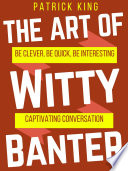

Timing is crucial in witty banter. Knowing when to interject a clever remark or a humorous observation can elevate a conversation. The book emphasizes the need to be attuned to the rhythm of dialogue, which allows for the perfect moment to deliver a punchline or a clever comeback. This involves active listening and being aware of the emotional state of those involved in the conversation. Effective banter often requires a delicate balance; too early, and the humor may fall flat, too late, and the moment may be lost. The book provides examples and exercises to help readers develop their sense of timing, illustrating how great comedians and conversationalists master this skill. By mastering timing, one can create a more engaging and enjoyable interaction, making conversations memorable and enjoyable.
Continue readingA key component of witty banter is having a mental library of clever remarks and observations. The book encourages readers to cultivate a collection of jokes, puns, and humorous anecdotes that can be drawn upon in various situations. This repertoire allows for quick and spontaneous responses that can keep conversations lively. The author suggests practicing these remarks in low-stakes environments to build confidence and fluency. Additionally, the book highlights the importance of tailoring these remarks to suit the audience and context, ensuring that humor is appropriate and well-received. By having a diverse set of witty remarks at one's disposal, a person can navigate social interactions with ease and charm.
Continue readingSelf-deprecating humor is a powerful tool in witty banter. The book explains how making light of one’s own flaws or experiences can create a sense of relatability and openness in conversations. This type of humor can disarm others and foster a more relaxed atmosphere, encouraging others to join in the fun. However, the author cautions against overdoing it, as excessive self-deprecation can come off as insecurity. The key is to strike a balance, using self-deprecation to enhance the conversation rather than detract from one’s self-esteem. The book provides practical tips on how to incorporate self-deprecating humor effectively, helping readers to connect with others while maintaining their confidence.
Continue readingPlayfulness is a central theme in witty banter. The book emphasizes that a light-hearted approach can transform mundane conversations into enjoyable exchanges. Playfulness invites creativity and spontaneity, allowing for unexpected twists and turns in dialogue. The author encourages readers to embrace a playful mindset, which can lead to more engaging and fun interactions. This involves being open to absurdity, playful teasing, and imaginative scenarios. The book offers exercises to help readers tap into their playful side, ultimately enhancing their ability to engage in witty banter. By fostering a playful atmosphere, individuals can create connections and build rapport with others.
Continue readingObservational humor is the art of finding humor in everyday situations and experiences. The book highlights the importance of being observant and noticing the quirks of life that often go unnoticed. By honing this skill, individuals can enrich their banter with relatable and funny observations. The author provides examples of great comedians who excel in observational humor and encourages readers to practice this skill by keeping a journal of funny observations. This not only sharpens one’s wit but also enhances the ability to connect with others through shared experiences. The book illustrates how observational humor can serve as a bridge between individuals, making conversations more engaging and enjoyable.
Continue readingUnderstanding social cues is essential for effective witty banter. The book discusses the importance of being attuned to body language, tone of voice, and facial expressions. These cues provide valuable information about how others are responding to the conversation and whether humor is landing well. The author emphasizes the need for empathy and awareness in social interactions, as this can guide the direction of the banter. By reading social cues, individuals can adjust their approach, ensuring that their humor is well-timed and appropriate. The book includes practical exercises to improve this skill, helping readers to become more adept at navigating social dynamics.
Continue readingThe book concludes with the idea that witty banter should contribute to a positive social environment. It emphasizes that humor should be inclusive and uplifting, rather than at someone else's expense. The author encourages readers to focus on creating joy and connection through their banter, fostering a sense of community and camaraderie. This involves being mindful of the feelings of others and ensuring that humor does not alienate or offend. The book provides strategies for maintaining a positive atmosphere, such as encouraging others to participate in the banter and celebrating shared laughter. By prioritizing positivity, individuals can enhance their social interactions and build lasting relationships.
Continue reading